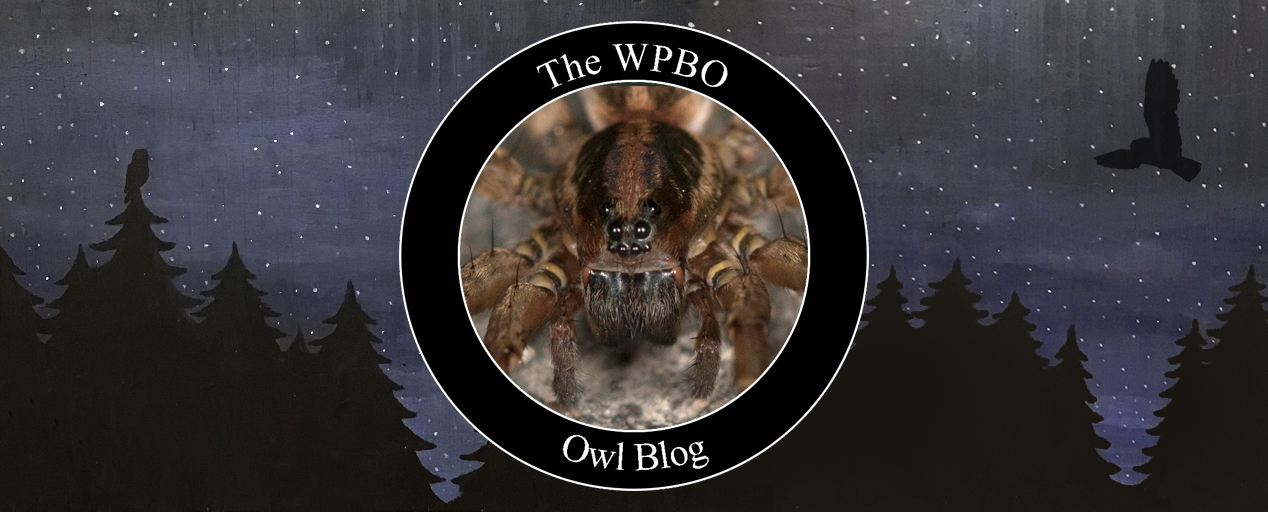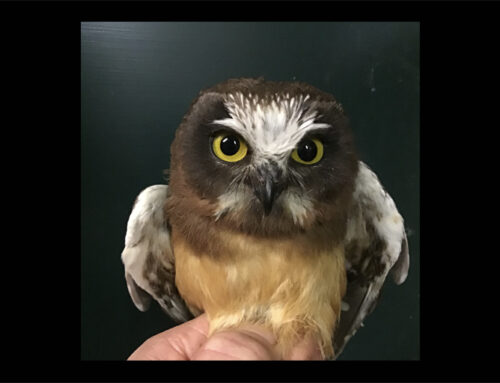The owl migration slowed a bit this past week but remained steady. After the record night of 71 Long-eared Owls (LEOW) on April 9, we have not banded more than 18 LEOW on a given night. We’re seeing a few more of last year’s young mixing in with the adults, but that transition has not kicked in yet. We also started seeing a few more males this past week. Females always outnumber the males we band, but the male numbers were notably low when that big push came through. Females are buffier than males, with males being whiter than the females. The extremes of both sexes are particularly beautiful in their own right, but given that we see much fewer light males, we tend to appreciate that opportunity a bit more.
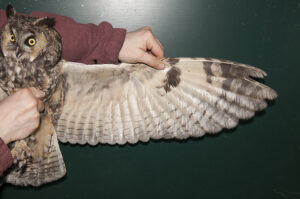
One of this spring’s few male Long-eared Owls. Photo by Chris Neri
Northern Saw-whet Owl (NSWO) numbers were admittedly a bit disappointing this past week, with just 35 being banded. Their numbers have been a bit unpredictable in recent years, but we hope that they pick up again as the weather warms up a bit. Aside from the NSWO and LEOW, we banded five more Barred Owls and one more Boreal Owl this week.
Given we don’t have any new owl species for you this week, we’re sharing a shot of another predator we regularly see in the woods at night. We’ve learned to recognize the eyeshine that some spiders give in our headlamps. Wolf spiders are the ones that we notice the most. I got this close-up of a wolf spider’s eyes on a recent night. We should all be grateful that these guys are so small; we would definitely never take an owl banding job in Mirkwood Forest (a reference for fellow Tolkien fans).
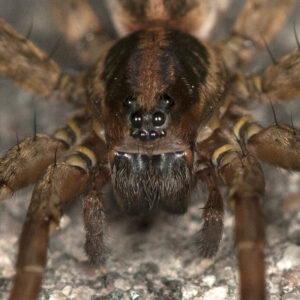
Season Totals of Banded Owls
Northern Saw-whet Owls: 352
Long-eared Owls: 195
Boreal Owl: 9
Barred Owl: 7
Great Horned Owl: 1
Total Owls: 563
~ Chris Neri & Nova Mackentley
2024 Spring Owl Banders
You can read the owl banders’ weekly blog posts and follow WPBO’s social media (Facebook, Instagram, and X) for owl banding highlights this season.
The spring owl banding season runs from March 15 through May 31.
Owl Banding Presentations — Visitors may observe owls that have been banded on Friday and Saturday evenings from dusk until midnight. Please note that banding is weather dependent and it is at the banders’ discretion to cancel banding accordingly. Observation will be limited to outdoors only. For the safety of the owls, flash photography and recording video is prohibited.
Nova Mackentley and Chris Neri: 2024 Spring Owl Banders
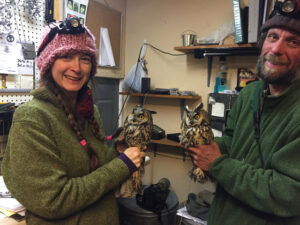 A lifelong birder, Chris became particularly fascinated with owls at the age of eight. He was introduced to owl banding by Katy Duffy in Cape May, NJ, in the mid-90s and knew after the first night that his life had just been changed. He has since worked with birds of prey in NV, NJ, NM, ID, CA, OR, MN, and his home state of PA. His life changed again when he arrived for his first season of owl banding at WPBO in the spring of 1999. As he puts it, “I have been fortunate enough to spend seasons at some of the premier raptor sites around the country working on some great research projects, but nothing has captured me the way the owl migration at Whitefish Point has.”
A lifelong birder, Chris became particularly fascinated with owls at the age of eight. He was introduced to owl banding by Katy Duffy in Cape May, NJ, in the mid-90s and knew after the first night that his life had just been changed. He has since worked with birds of prey in NV, NJ, NM, ID, CA, OR, MN, and his home state of PA. His life changed again when he arrived for his first season of owl banding at WPBO in the spring of 1999. As he puts it, “I have been fortunate enough to spend seasons at some of the premier raptor sites around the country working on some great research projects, but nothing has captured me the way the owl migration at Whitefish Point has.”
Originally from upstate New York, Nova first came to Michigan as a pianist and graduated from Interlochen Arts Academy. From there, it was an adventurous trek through Carnegie Mellon University and Oberlin College, studying abroad in Tanzania and earning her B.A. in Biology. Nova has loved Whitefish Point and the unique owl migration from the minute she was first hired as an owl bander back in 2005. She has worked with passerines, owls, hawks, parrots, ground squirrels, and ocelots at various field sites worldwide, but the owls always bring her back to Whitefish Point.
During their many years at WPBO, Nova and Chris have substantially upgraded the spring owl banding, discovered a unique movement of juvenile Northern Saw-whet Owls during the summer, coauthored several papers on owls, and feel grateful to call the U.P. their home. As nature photographers, Whitefish Point and its wonders have inspired much of their photography.

